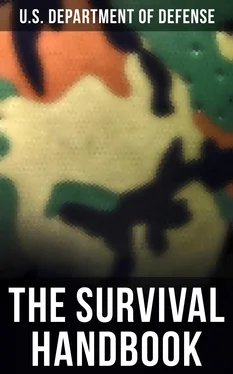U.S. Department of Defense
Find Water & Food in Any Environment, Master Field Orientation and Learn How to Protect Yourself
Published by

Books
- Advanced Digital Solutions & High-Quality eBook Formatting -
musaicumbooks@okpublishing.info
2020 OK Publishing
EAN 4064066394035
Chapter 1. Introduction Chapter 1. Introduction Table of Contents This manual is based entirely on the keyword SURVIVAL. The letters in this word can help guide you in your actions in any survival situation. Whenever faced with a survival situation, remember the word SURVIVAL.
Survival Actions
Pattern for Survival
Chapter 2. Psychology of Survival
A Look at Stress
Natural Reactions
Preparing Yourself
Chapter 3. Survival Planning and Survival Kits
Importance of Planning
Survival Kits
Chapter 4. Basic Survival Medicine
Requirements for Maintenance of Health
Medical Emergencies
Lifesaving Steps
Bone and Joint Injury
Bites and Stings
Wounds
Environmental Injuries
Herbal Medicines
Chapter 5. Shelters
Shelter Site Selection
Types of Shelters
Chapter 6. Water Procurement
Water Sources
Still Construction
Water Purification
Water Filtration Devices
Chapter 7. Firecraft
Basic Fire Principles
Site Selection and Preparation
Fire Material Selection
How to Build a Fire
How to Light a Fire
Chapter 8. Food Procurement
Animals for Food
Traps and Snares
Killing Devices
Fishing Devices
Preparation of Fish and Game for Cooking and Storage
Chapter 9. Survival Use of Plants
Edibility of Plants
Plants for Medicine
Chapter 10. Poisonous Plants
How Plants Poison
All About Plants
Rules for Avoiding Poisonous Plants
Contact Dermatitis
Ingestion Poisoning
Chapter 11. Dangerous Animals
Insects and Arachnids
Leeches
Bats
Poisonous Snakes
Dangerous Lizards
Dangers in Rivers
Dangers in Bays and Estuaries
Saltwater Dangers
Chapter 12. Field-Expedient Weapons, Tools, and Equipment
Clubs
Edged Weapons
Other Expedient Weapons
Lashing and Cordage
Rucksack Construction
Clothing and Insulation
Cooking and Eating Utensils
Chapter 13. Desert Survival
Terrain
Environmental Factors
Need for Water
Heat Casualties
Precautions
Desert Hazards
Chapter 14. Tropical Survival
Tropical Weather
Jungle Types
Travel Through Jungle Areas
Immediate Considerations
Water Procurement
Food
Poisonous Plants
Chapter 15. Cold Weather Survival
Cold Regions and Locations
Windchill
Basic Principles of Cold Weather Survival
Hygiene
Medical Aspects
Cold Injuries
Shelters
Fire
Water
Food
Travel
Weather Signs
Chapter 16. Sea Survival
The Open Sea
Seashores
Chapter 17. Expedient Water Crossings
Rivers and Streams
Rapids
Rafts
Flotation Devices
Other Water Obstacles
Vegetation Obstacles
Chapter 18. Field-Expedient Direction Finding
Using the Sun and Shadows
Using the Moon
Using the Stars
Making Improvised Compasses
Other Means of Determining Direction
Chapter 19. Signaling Techniques
Application
Means for Signaling
Codes and Signals
Aircraft Vectoring Procedures
Chapter 20. Survival Movement in Hostile Areas
Phases of Planning
Execution
Return to Friendly Control
Chapter 21. Camouflage
Personal Camouflage
Methods of Stalking
Chapter 22. Contact With People
Contact With Local People
The Survivor's Behavior
Changes to Political Allegiance
Chapter 23. Survival in Man-Made Hazards
The Nuclear Environment
Biological Environments
Chemical Environments
Table of Contents
 This manual is based entirely on the keyword SURVIVAL. The letters in this word can help guide you in your actions in any survival situation. Whenever faced with a survival situation, remember the word SURVIVAL. This manual is based entirely on the keyword SURVIVAL. The letters in this word can help guide you in your actions in any survival situation. Whenever faced with a survival situation, remember the word SURVIVAL. |
Table of Contents
The following paragraphs expand on the meaning of each letter of the word survival. Study and remember what each letter signifies because you may some day have to make it work for you.
S -Size Up the Situation
If you are in a combat situation, find a place where you can conceal yourself from the enemy. Remember, security takes priority. Use your senses of hearing, smell, and sight to get a feel for the battlefield. What is the enemy doing? Advancing? Holding in place? Retreating? You will have to consider what is developing on the battlefield when you make your survival plan.
Size Up Your Surroundings
Determine the pattern of the area. Get a feel for what is going on around you. Every environment, whether forest, jungle, or desert, has a rhythm or pattern. This rhythm or pattern includes animal and bird noises and movements and insect sounds. It may also include enemy traffic and civilian movements.
Size Up Your Physical Condition
The pressure of the battle you were in or the trauma of being in a survival situation may have caused you to overlook wounds you received. Check your wounds and give yourself first aid. Take care to prevent further bodily harm. For instance, in any climate, drink plenty of water to prevent dehydration. If you are in a cold or wet climate, put on additional clothing to prevent hypothermia.
Size Up Your Equipment
Perhaps in the heat of battle, you lost or damaged some of your equipment. Check to see what equipment you have and what condition it is in.
Now that you have sized up your situation, surroundings, physical condition, and equipment, you are ready to make your survival plan. In doing so, keep in mind your basic physical needs--water, food, and shelter.
U -Use All Your Senses, Undue Haste Makes Waste
You may make a wrong move when you react quickly without thinking or planning. That move may result in your capture or death. Don't move just for the sake of taking action. Consider all aspects of your situation (size up your situation) before you make a decision and a move. If you act in haste, you may forget or lose some of your equipment. In your haste you may also become disoriented so that you don't know which way to go. Plan your moves. Be ready to move out quickly without endangering yourself if the enemy is near you. Use all your senses to evaluate the situation. Note sounds and smells. Be sensitive to temperature changes. Be observant.
R -Remember Where You Are
Spot your location on your map and relate it to the surrounding terrain. This is a basic principle that you must always follow. If there are other persons with you, make sure they also know their location. Always know who in your group, vehicle, or aircraft has a map and compass. If that person is killed, you will have to get the map and compass from him. Pay close attention to where you are and to where you are going. Do not rely on others in the group to keep track of the route. Constantly orient yourself. Always try to determine, as a minimum, how your location relates to-
Читать дальше


 This manual is based entirely on the keyword SURVIVAL. The letters in this word can help guide you in your actions in any survival situation. Whenever faced with a survival situation, remember the word SURVIVAL.
This manual is based entirely on the keyword SURVIVAL. The letters in this word can help guide you in your actions in any survival situation. Whenever faced with a survival situation, remember the word SURVIVAL.










